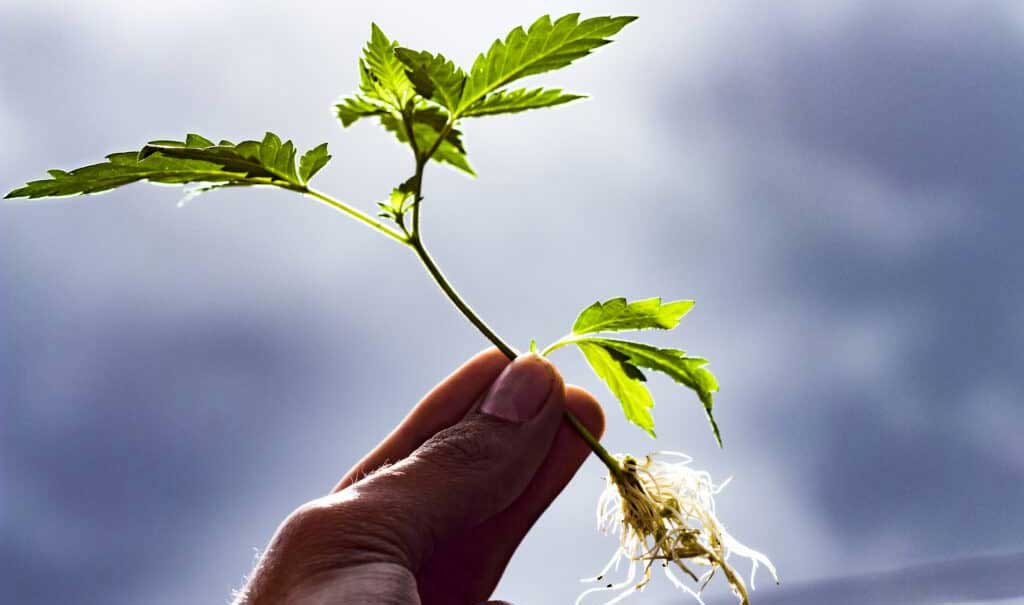One of the most critical topics every grower needs to understand about LED grow lights (and heat sink technology) is thermal management. So, what exactly does this mean, and are you going to need an electrical engineering degree to go any further?
The answer to the second question is no, but the answer to the first question is this: Thermal management is simply how is the heat that is generated by your grow lights is removed from the area – and how fast – so your plants aren’t damaged and your lights themselves aren’t destroyed.
Fundamentally, LEDs are electronic devices and subject to potentially overheating. Like cell phones, heat must be managed to avoid damaging the device. That’s why most cell phone cases are made of aluminum and not plastic. We’ll discuss aluminum later.
LED grow lights operate at much cooler physical temperatures and convert more electrical energy input into useful light, rather than wasteful excess heat, than other lighting technologies. Nonetheless, heat will build up in the semiconductor driver circuitry of an LED light, and that heat can degrade performance and shorten the life of the fixture and system over time, not to mention that excess heat is a major factor in indoor cultivation facilities.
At SpecGrade LED, our heat sink technology is some of the best around. While there is a whole science around thermal management, as a grower, you don’t need to understand the intricacies or high-level theories to get a top-quality grow light with heat sink technology.
But it is helpful to understand, on a basic level, the Arrhenius Equation, which – in a nutshell – means as heat goes up, life goes down. In the case of LED grow lights, this means, if your lights burn too hot and the heat isn’t removed quickly, your lights will end up in the landfill and your plants will suffer.

So, that said, how do you make sure you are getting the best quality LED grow lights with industry-leading heat sink technology? Here are some things to understand, so when you are shopping for grow lights, you’ll know what to ask.
What you need to know about heat sink technology
There are really only two ways to make sure your grow lights aren’t going to get too hot. The first way is active cooling and the second way is passive cooling.
In active cooling, fans are used to pull the heat away from the LED grow light and while this does work, the fans built into the lights introduce another failure point. It’s a common tool, but in our opinion, it’s poor engineering. If your fan breaks, your lights will get too hot and they will break. Meaning, you are back at square one and you need new grow lights.

In passive cooling, which in our opinion is the superior method, a large surface area of aluminum is used, which pulls the heat from the light and sends it up (you might remember learning in school that heat rises) away from the plants. And the more surface area that your light has that is aluminum, the more heat that can come off – and fast. Aluminum employed in this manner is referred to as a heat sink because the heat is absorbed by or sinks into the aluminum to be dissipated at its furthest edges from the heat source.

Although heat sink engineering excellence is fairly straight forward, proper engineering for LED grow lights involves more aluminum (a relatively inexpensive and effective conductive material). Thickness, size and how it connects to the substrate all come into play when it comes to truly effective passive cooling.
At SpecGrade LED, the heat sink technology we pioneered in our industrial and hazardous location fixtures combines multiple double-folded aluminum fins that provide more than 70 square feet of heat transfer surface with thermal bonding that improves the movement of built-up heat from the base of an LED light and into the ambient environment.

SpecGrade LED’s Verta-8 lights have almost 5,000 square inches of heat sink technology – an industry leading number. This allows the Verta-8 to function cooler than almost all other competitive grow lights.
For example, the average competitor’s light, which uses a different design and surface area, has 800-900 square inches of heat sink technology – obviously, significantly lower. That means the radiant heat coming off the LED grow light not only rises, but is also forced downward onto the plants. And if you remember the Arrhenius Equation, you’ll recall that as the fixture’s temperature increases, the lifespan of the grow light decreases – which is never a good thing for a grower.
Our heat sink technology will keep your lights cooler – which means they last longer – and in an expensive investment like grow lights, isn’t that what you want? We thought so.
How to know if the heat sink works
Whether you’re measuring lights you already own, are testing or looking at in a grow shop there is a relatively quick way to see how well the heat sink works. Turn the grow light on and let it warm up. When comparing multiple lights side-by-side, ensure that they are all operating at the same brightness level, particularly if a dimmer is involved. You’ll want to give the light(s) about 15 minutes before measuring their temperature.
Once the grow light(s) have warmed up, employ an infrared thermometer to measure the heat on both sides. You’ll see the differences best when the light(s) are operating at 100%. Be careful not to touch it/them, with many grow lights that’s an easy way to burn your fingers.
When a heat sink isn’t optimal the LED side of the light will be significantly hotter than the top or back side. On some grow lights, the difference can be more than 10 degrees. Remember, what you’re looking for is that the LED side is cooler than the top because the heat is supposed to be drawn away from the LEDs.
SpecGrade LED’s technology
SpecGrade LED’s heat sink technology is more than just a set of old-school fins that are attached to an existing product. Our engineers have specifically designed our grow lights from the ground up with heat sinks built into the housing design and configured to optimize all aspects of indoor grow lighting performance.
Different plant varietals that are commonly cultivated in indoor growing facilities pose different lighting challenges. A cultivator, for example, might need to mount lighting fixtures in close proximity to plants for optimum chlorophyll generation in those plants or because of the space limitation in a racing application. Fixtures that operate at too high of a physical temperature or that are not designed specifically for cultivation facilities will not give the cultivator the flexibility to do this.
SpecGrade LED met this challenge by engineering an integrated fixture housing with electronics, optics, and advanced heat sink technology that work together to provide a precision lighting instrument that gives years of high-quality lighting performance and complete control to the grower.

SpecGrade LED’s engineering has also factored in the high-humidity environments that are common in indoor plant cultivation facilities. A fixture that is not designed for that environment will experience corrosion and degradation as ambient moisture seeps into the fixture over time.
We designed our grow lighting technology to be moisture resistant, with exterior finishes and casings that are more impervious to humidity and corrosion-resistant materials for the greatest advance in LED grow lighting on the modern market.
It’s a tangible feeling of durability that our growers remark on frequently. It provides peace of mind growers rely on from propagation to flowering, season after season.
The Key Takeaway
The key takeaway for growers doing research into investing in LED grow lights is this: Heat sink technology matters a great deal when comparing one manufacturer’s lights to another.
A better-quality grow light means better quality heat sink technology.


